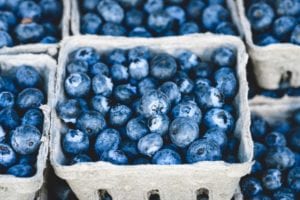Written by Jessica Patella, ND. Study suggests that blueberries may positively affect pain management, improve gait performance, and contribute to better physical functionality for patients with osteoarthritis.
 Osteoarthritis is the most common joint disorder in the world and is the primary cause of walking-related disabilities in the United States, effecting an estimated 22.7% of the population 1-3. Osteoarthritis causes, pain, aching, stiffness and decreased flexibility that affects joint cartilage and bones of the joint 1,2. The underlying cause of osteoarthritis is inflammation of the joints 1. Recent research has found that supplementing with blueberries, because of their ability to decrease inflammation, can improve the pain, inflammation and gait performance in adults with osteoarthritis 1.
Osteoarthritis is the most common joint disorder in the world and is the primary cause of walking-related disabilities in the United States, effecting an estimated 22.7% of the population 1-3. Osteoarthritis causes, pain, aching, stiffness and decreased flexibility that affects joint cartilage and bones of the joint 1,2. The underlying cause of osteoarthritis is inflammation of the joints 1. Recent research has found that supplementing with blueberries, because of their ability to decrease inflammation, can improve the pain, inflammation and gait performance in adults with osteoarthritis 1.
There is growing research that increased consumption of dietary polyphenols reduces the risk of multiple diseases because of their antioxidant capacity 1,4. Blueberries, high in polyphenols and flavonoids, are antioxidants that have been shown to have an anti-inflammatory 5 effect and possibly increase cartilage activity 1,6. This is the first study to investigate the effect of blueberries on pain reduction, gait performance and inflammation in those with osteoarthritis 1.
A total of 63 men and women (45-79 years of age) with self-reported osteoarthritis were included in the study. Participants agreed not to take any COX-2 inhibitors (a class of arthritis pain drugs), chondroitin sulfate, glucosamine sulfate or blueberry products during the study 1. Participants were then randomized to either the blueberry group (n=33) or the placebo group (n=30). The participants in the blueberry group received 40 g (about 1.5 ounces) of freeze-dried whole blueberry powder daily while the placebo group received a color-matched maltodextrin powder to be consumed in 10-12 ounces of water, for a total of 4-months 1.
The results were as follows:
- Pain, stiffness and difficulty to perform daily activities all significantly decreased in the blueberry group (p<0.05), while there were no changes in the placebo group (via WOMAC scores)
- Normal walking pace increased significantly in the blueberry group (p=0.007) while there was no change in the placebo group.
- The only difference observed in blood inflammatory markers was a trend increase in IL-13 and a decreased trend in MCP-1, although these did not reach significance.
Supplementing with freeze dried blueberry powder daily decreased pain, stiffness and difficulty performing daily activities, while improving gait performance. The researchers postulated that the addition of blueberries to the diet may have a long-term impact of quality of life in individuals with osteoarthritis of the knee 1.
Source: Du, Chen, Amy Smith, Marco Avalos, Sanique South, Keith Crabtree, Wanyi Wang, Young-Hoo Kwon, Parakat Vijayagopal, and Shanil Juma. “Blueberries Improve Pain, Gait Performance, and Inflammation in Individuals with Symptomatic Knee Osteoarthritis.” Nutrients 11, no. 2 (2019): 290.
© 2019 by the authors. Licensee MDPI, Basel, Switzerland. This article is an open access article distributed under the terms and conditions of the Creative Commons Attribution (CC BY) license (http://creativecommons.org/licenses/by/4.0/).
Click here to read the full text study.
Posted December 9, 2019.
References:
- Du C, Smith A, Avalos M, et al. Blueberries Improve Pain, Gait Performance, and Inflammation in Individuals with Symptomatic Knee Osteoarthritis. Nutrients. 2019;11(2):290.
- Felson DT, Lawrence RC, Dieppe PA, et al. Osteoarthritis: new insights. Part 1: the disease and its risk factors. Annals of internal medicine. 2000;133(8):635-646.
- Barbour KE, Helmick CG, Boring M, Brady TJ. Vital signs: prevalence of doctor-diagnosed arthritis and arthritis-attributable activity limitation—United States, 2013–2015. MMWR Morbidity and mortality weekly report. 2017;66(9):246.
- Clifford MN. Chlorogenic acids and other cinnamates–nature, occurrence and dietary burden. Journal of the Science of Food and Agriculture. 1999;79(3):362-372.
- McAnulty LS, Nieman DC, Dumke CL, et al. Effect of blueberry ingestion on natural killer cell counts, oxidative stress, and inflammation prior to and after 2.5 h of running. Applied Physiology, Nutrition, and Metabolism. 2011;36(6):976-984.
- Trzeciakiewicz A, Habauzit V, Horcajada M-N. When nutrition interacts with osteoblast function: molecular mechanisms of polyphenols. Nutrition Research Reviews. 2009;22(1):68-81.

